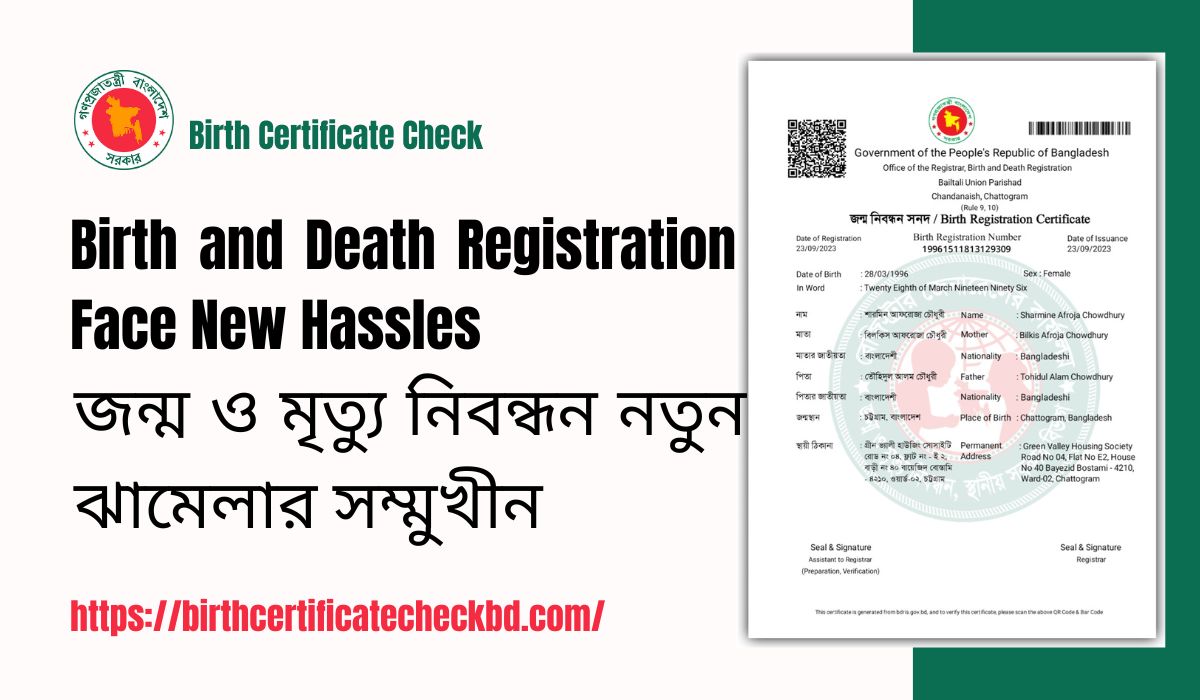Birth and Death Registration Face New Hassles. Birth and death registration is a crucial administrative process in Bangladesh, ensuring the legal identity of citizens and maintaining accurate demographic records. However, recent disruptions in the online fee submission system have led to significant challenges for applicants.
From technical issues to manual payment hassles, citizens have been struggling with the process. This article explores the reasons behind these difficulties, their impact on the people, and possible solutions to streamline the registration system.
Manual Payment Hassles for Birth and Death Registration
One of the major setbacks in birth and death registration has been the suspension of e-payment services. Since the last week of November, applicants have been unable to submit registration fees online. Instead, they are required to visit local registrar offices and pay manually, which has caused inconvenience and delays.
Previously, the e-payment system allowed seamless transactions through the finance ministry’s iBAS++ (Integrated Budget and Accounting System). However, due to overwhelming demand for new registrations and corrections of old records, the system could not handle the workload, leading to its suspension.
For instance, Kazi Saifuddin Hossain, a resident of Mohammadpur, needed his birth registration certificate for family-related purposes. Similarly, Arefin Amin Rohan had to correct the names on his birth certificate and those of his parents. Both individuals initially applied online but had to visit the registrar’s office to manually pay their fees of Tk 50.
Who is Responsible for Registration?
The responsibility of birth and death registration lies with:
- Ward councilors
- Municipality mayors
- Union Parishad chairmen
According to Syed Hasan Noor Islam, councilor of ward no. 32 in Dhaka North City Corporation (DNCC), the e-payment system has been non-functional for months, forcing applicants to submit their fees in person. The collected fees are then deposited into the state treasury via Challan.
High Volume of Applications
The volume of birth and death registrations in Bangladesh is substantial. On 6 May, over 58,749 manual payments were recorded, while 69,908 applications were submitted for new registrations and corrections. Between January and April, 3.2 million birth registrations and 288,000 death registrations were processed.
E-payment for these services was first introduced in May 2023, following a successful pilot program in Madhainagar Union Parishad, Sirajganj, and Meherpur Municipality. The system was designed to automate payments through iBAS++, allowing the government to efficiently manage budgeting, fund allocation, and revenue deposits.
Why Was E-Payment Suspended?
The challenges in the e-payment system were not sudden. Since mid-2023, birth registration had become an arduous task due to frequent server downtimes. From June to November, applicants often faced system failures and were informed that the “server is down.”
The core issue was the limited storage capacity of the Birth and Death Registration Information System (BDRIS). The excessive number of applications caused the system to slow down significantly.
Additionally, concerns about data security surfaced after TechCrunch, a US-based technology media outlet, reported a massive data leak involving personal information from a Bangladeshi government website. Following this revelation, online application services were suspended throughout August 2023.
Although self-applications resumed in September, e-payment remained problematic. Users encountered slow responses or system failures while making payments. To tackle these difficulties, the Office of the Registrar General, Birth and Death Registration introduced manual payments from 26 November 2023, and by 30 November, the e-payment system was completely shut down.
Impact of Manual Payment System
Despite its drawbacks, manual payment has led to a sharp increase in registrations. The number of registrations soared to 600,000 in November and surpassed 1 million in December 2023. However, the inconvenience faced by applicants remains a pressing concern.
Registrar General Md Zahid Hossain explained that, on average, over 100,000 transactions take place daily, including new registrations and corrections. The iBAS++ system was unable to handle such high volumes, leading to its temporary suspension.
To ensure continued service, authorities decided to maintain manual payments until the issue is resolved. Additionally, discussions are ongoing about introducing a dual-payment system, allowing both online and offline transactions to ease the burden on citizens.
Server Upgrades and Future Improvements
There have been improvements in the server’s performance since suspending e-payments. According to Zahid Ferdous, secretary of DNCC ward no. 32, the system now experiences fewer downtimes—typically lasting only one or two days at a time.
The government has also taken measures to enhance system capacity. In April 2024, the storage capacity of the BDRIS was expanded from 72 terabytes to 322 terabytes, improving efficiency in processing applications.
Possible Solutions for a Seamless Registration Process
To ensure a smooth birth and death registration process, authorities should consider:
- Reactivating E-Payment with System Upgrades: Strengthening the iBAS++ infrastructure to handle high traffic.
- Hybrid Payment System: Keeping both online and manual payment options available.
- Enhancing Server Storage and Speed: Further upgrading server capacity to prevent slowdowns.
- Improving Cybersecurity: Implementing robust security protocols to prevent data breaches.
- Introducing a Mobile App for Registration: A dedicated app could simplify the process and reduce manual workload.
Conclusion
Birth and death registration is an essential service, yet recent challenges in e-payment and system management have created hurdles for citizens. While manual payments have provided a temporary solution, long-term improvements in server infrastructure and payment systems are crucial. By implementing a hybrid payment model, enhancing cybersecurity, and upgrading digital infrastructure, Bangladesh can ensure a seamless, efficient, and secure registration process for all its citizens.

